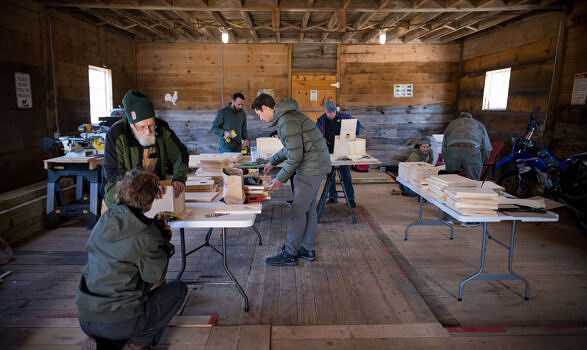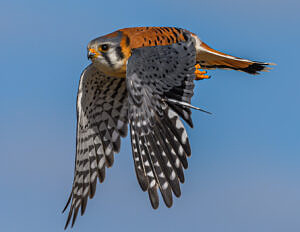Supporting Breeding Kestrels in the Monadnock Region
American Kestrels — small, colorful falcons of grasslands and agricultural areas — have declined across much of their breeding range and are a Species of Special Concern in New Hampshire. Although open landscapes still exist in nearly every town, well-placed natural cavities for nesting are seemingly less available. This spring, Harris Center volunteers, interns, and staff constructed and placed over 20 nest boxes for American Kestrels in 11 towns across the Monadnock Region.
Guided by a habitat model created by past Harris Center Bird Conservation Intern Will Stollsteimer, the team identified suitable landscapes for breeding kestrels and sought out landowner permission to mount nest boxes in priority areas. Over the past month, Bird Conservation Director Phil Brown and current Bird Conservation Intern Mike Valentino have been busy installing the boxes, and kestrel pairs have already shown interest at some sites! The interns plan to monitor these boxes through July, when any chicks should be ready to fledge.
Volunteers busy at work constructing kestrel boxes! (photo © Ben Conant)

Phil and Mike raise a kestrel box. (photo © Meade Cadot)

Conserving an Iconic Species

An American Kestrel in flight. (photo © Susan Kline)
Through this project, the Harris Center hopes to increase the breeding population of kestrels in the Monadnock Region and educate landowners and the general public about the importance of high-quality habitat for kestrels and other wildlife species of open lands. This project has already sparked tremendous engagement with landowners and has the potential to involve communities in kestrel conservation. Long-term monitoring efforts, which may include the banding of nestlings, can yield data related to kestrel longevity, nestling survivorship, nest site fidelity, and conservation of this iconic grassland species.
Contact Us
For more information, please contact Bird Conservation Director Phil Brown at (603) 525-3394 or by email.


